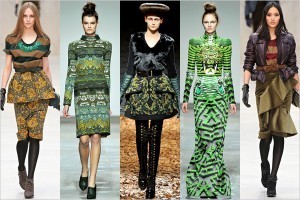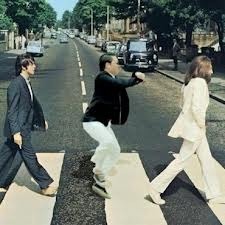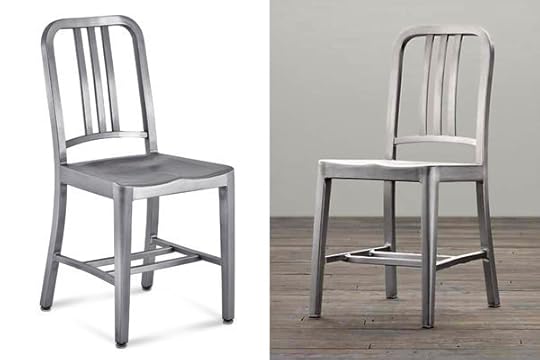Christopher Sprigman's Blog, page 7
October 17, 2012
Can you post lyrics to popular songs online?

Lots of people like to look up song lyrics online, maybe to decide an argument in a bar or just to sing along better in their car. This month our ability to do that took a hit, when a California judge ruled that LiveUniverse had infringed the copyrights on over 500 songs when it posted the lyrics online, including those to David Bowie’s “China Girl.” The judgment was $6.6 million.
As Business Insider notes,
That’s right—the lyrics, not the song themselves.
The music publishers that hold the copyrights will get $12,500 per song, totaling a massive $6.6 million in damages, plus attorney fees, according to a press release mailed out by Arent Fox.
Megan McArdle on The Knockoff Economy
 Writing in The Daily Beast, influential journalist and economics blogger Megan McArdle picks up on a feature of The Knockoff Economy that we’re always happy to have someone notice — we are not IP abolitionists, and we think that IP law has an important role to play in encouraging creativity. And although we think that industries like food, fashion, and others that innovate without much reliance on IP have something to teach us about the future of traditionally IP-reliant industries like music and film, it’s important not to over-state the degree to which these very different sorts of industries are likely ever to run on the same logic.
Writing in The Daily Beast, influential journalist and economics blogger Megan McArdle picks up on a feature of The Knockoff Economy that we’re always happy to have someone notice — we are not IP abolitionists, and we think that IP law has an important role to play in encouraging creativity. And although we think that industries like food, fashion, and others that innovate without much reliance on IP have something to teach us about the future of traditionally IP-reliant industries like music and film, it’s important not to over-state the degree to which these very different sorts of industries are likely ever to run on the same logic.
Indeed, a central message of our book is that all creative industries are different. Some need IP more than others. Some don’t need it at all. Now, despite these obvious differences, the IP system tends to treat all creative industries alike. Copyright law, for example, imposes the same basic rules on hundred-million-dollar motion pictures and two-cent shampoo bottle labels. And patent law imposes the same rules on new drugs, which are often stupendously expensive to produce, that apply to Amazon’s patent on a “one-click” method of online ordering, which someone probably dreamed up and implemented in a few weeks and at very little cost. (Actually, that Amazon patent never should have been granted in the first place. “One-click” was obvious to anyone who thought about the issue at all, not least because the previous ordering method required two clicks.)
McArdle draws from our work something that we very much hope to get across — we should start thinking about ways to make IP law better at addressing the different characteristics of very different creative industries. Do fashion, food, football, and fonts need more IP? Not that we can see. Does the pharmaceutical industry need the high levels of IP protection it enjoys under current law? Well, considering how expensive it is to discover new drugs and get them through FDA-compliant clinical trials, the case for patent protection in pharma is much, much stronger. How else would pharma companies attract the kind of capital they need to get new drugs off the lab bench and into the FDA pipeline?
So fashion and food may be on one end of the spectrum (the low-IP end), and pharma on the other. And in the middle sit a variety of other, important creative industries. Let’s just consider one we tend to obsess about — music. For decades, music was a high-IP industry — that is, it relied on strong and enforceable copyright as the basis of its business model. Well, along came Napster in 1999, and we all know what happened next. The music industry’s copyright-centered business model went “poof”. And we doubt that there’s anything that the industry, or government, can do that will make copyright work again as the central piece of the music industry’s business model.
So it’s time to start thinking about what a less copyright-reliant music industry could look like. In some ways, that shift is already happening. The live concert, which is really selling an experience rather than a product, is much harder to copy than a CD or digital download. And so live music is re-emerging as a growth area. That’s just one of a host of changes that are, over time, likely to make the music industry less susceptible to copying. Time will tell, but we’re betting that in 20 years the music industry will look more like fashion than pharma. And it will be making a lot of great music — and some money as well.
Ars Technica on the new fashion copyright bill
 From Ars Technica’s Tim Lee, a great summary of the new bill, introduced by Sen. Chuck Schumer, that would extend copyright protection to fashion designs. We think that’s a bad idea and far more likely to impede creativity in fashion than to aid it. Tim interviewed one of us (Sprigman) for the article, so we get a chance to explain why.
From Ars Technica’s Tim Lee, a great summary of the new bill, introduced by Sen. Chuck Schumer, that would extend copyright protection to fashion designs. We think that’s a bad idea and far more likely to impede creativity in fashion than to aid it. Tim interviewed one of us (Sprigman) for the article, so we get a chance to explain why.
October 16, 2012
Pirates or Pioneers in China
 The Huffington Post has a newish service called HuffPost Live that is basically a streaming talk show with lots of segments, run using a Google+ hangout. Yesterday, I participated in one on Chinese copying that was pretty interesting. There were 5 participants with a varied set of views on copying generally and China’s commitment to IP specifically. The whole thing ran about 20 minutes or so. Check it out here.
The Huffington Post has a newish service called HuffPost Live that is basically a streaming talk show with lots of segments, run using a Google+ hangout. Yesterday, I participated in one on Chinese copying that was pretty interesting. There were 5 participants with a varied set of views on copying generally and China’s commitment to IP specifically. The whole thing ran about 20 minutes or so. Check it out here.
The Knockoff Economy on the Volokh Conspiracy — Creativity in Cuisine
 Kal and I are guest-blogging at widely-read libertarian/conservative legal blog The Volokh Conspiracy. Yesterday in our first post we introduced some of the big themes of The Knockoff Economy, and briefly explained why the fashion industry remains so creative despite having its central product—clothing designs—freely copied by any firm that thinks it can turn it a profit by aping an original design.
Kal and I are guest-blogging at widely-read libertarian/conservative legal blog The Volokh Conspiracy. Yesterday in our first post we introduced some of the big themes of The Knockoff Economy, and briefly explained why the fashion industry remains so creative despite having its central product—clothing designs—freely copied by any firm that thinks it can turn it a profit by aping an original design.
In our second post, we present a brief excerpt from the chapter on food to give a flavor (so to speak) of the book. In this excerpt, we discuss the incredibly creative culinary scene that now exists, and how copyright applies (or doesn’t) to cuisine. And we talk a bit about the story of the molten chocolate cake (pictured above), which, you have to admit, looks damn good.
October 15, 2012
Nobel-winning economist Eric Maskin — let’s scrap patents on software
 Nobel-winning Harvard economist Eric Maskin has a letter in today’s NY Times where he argues that patents for software should be scrapped. His point echos something we say in The Knockoff Economy — i.e., in creative industries where a lot of innovation involves incremental improvements to and extensions of others’ work (what we refer to as “tweaking”), patents (and copyrights) are often not necessary and indeed may impede creativity by discouraging tweaking. Here’s Maskin’s take:
Nobel-winning Harvard economist Eric Maskin has a letter in today’s NY Times where he argues that patents for software should be scrapped. His point echos something we say in The Knockoff Economy — i.e., in creative industries where a lot of innovation involves incremental improvements to and extensions of others’ work (what we refer to as “tweaking”), patents (and copyrights) are often not necessary and indeed may impede creativity by discouraging tweaking. Here’s Maskin’s take:
“[I]n the software industry, progress is highly sequential: progress is typically made through a large number of small steps, each building on the previous ones. If one of those steps is patentable, then the patent holder can effectively block (or at least slow down) subsequent progress by setting high license fees.
Moreover, like any other monopolist, it has the incentive to set such fees.
Thus, in an industry with highly sequential innovation, it may be better for society to scrap patents altogether than try to tighten them.”
The Knockoff Economy on The Volokh Conspiracy
 Kal and I will be guest-blogging this week on The Volokh Conspiracy, a great, lively and widely-read blog run by UCLA law professor Eugene Volokh (pictured left) and featuring posts from over a dozen of Eugene’s friends and colleagues, mostly from a libertarian or conservative perspective. Our first post is up now.
Kal and I will be guest-blogging this week on The Volokh Conspiracy, a great, lively and widely-read blog run by UCLA law professor Eugene Volokh (pictured left) and featuring posts from over a dozen of Eugene’s friends and colleagues, mostly from a libertarian or conservative perspective. Our first post is up now.
October 12, 2012
Siva Vaidhyanathan on why, as far as copyright law goes, universities are special
 You should check out this great piece in The Chronicle of Higher Education by colleague and friend Siva Vaidhyanathan explaining why, when it comes to copyright law, universities are special — that is, to fulfill their vital mission in our society, they need and deserve extra freedom to copy and use works of art, literature, science, and technology. Here’s how Siva puts it:
You should check out this great piece in The Chronicle of Higher Education by colleague and friend Siva Vaidhyanathan explaining why, when it comes to copyright law, universities are special — that is, to fulfill their vital mission in our society, they need and deserve extra freedom to copy and use works of art, literature, science, and technology. Here’s how Siva puts it:
“[U]niversities and their libraries have a special place in copyright law because they have a special place in society. Courts and even Congress have long acknowledged the essential role of copying in the educational process. That’s why the preamble to the section of the 1976 U.S. Copyright Act that outlines “fair use” specifies “teaching (including multiple copies for classroom use), scholarship, or research” as examples of “fair uses”—uses that, although they involve the copying of protected material, are considered noninfringing because they enable essential public goods.
Universities are not copyright-free zones—far from it. But they do perform special services that often demand flexibility and liberties that enable them to “promote the progress of science and useful arts,” the core mission of copyright as declared by the U.S. Constitution.”
We couldn’t agree more.
Copying Gangnam Style
 Unless you’ve been living under a rock, the Gangnam Style video, and even song, is pretty much inescapable now. But if you haven’t seen it, you can add to the almost 450 million views already in existence by watching here. But maybe you prefer one of the dozens of Gangnam Style parodies now circulating. Of course, Gangnam Style itself is sort of a parody (merged with satire) of mainstream K Pop songs and contemporary Korean life, which raises the question of whether you can parody a parody.
Unless you’ve been living under a rock, the Gangnam Style video, and even song, is pretty much inescapable now. But if you haven’t seen it, you can add to the almost 450 million views already in existence by watching here. But maybe you prefer one of the dozens of Gangnam Style parodies now circulating. Of course, Gangnam Style itself is sort of a parody (merged with satire) of mainstream K Pop songs and contemporary Korean life, which raises the question of whether you can parody a parody.
In any event, this is a blog about copying and IP. And a big question is, are these Gangnam style follow on videos legal? Luckily, Forbes is on the case with a post about this very issue:
Some commentators attribute the video’s success in part to the many parodies spawned by Psy’s original. Hundreds of remakes have been created, starring, among others: dancing babies, ponies, Batman, Gandalf, Navy midshipmen and a group of now-infamous lifeguards in El Monte, Calif.
Under the copyright law of most countries, public use of someone else’s creative work without the owner’s permission generally constitutes an infringement of the owner’s rights. You may be surprised to know, for example, that the song “Happy Birthday to You” is actually copyrighted and a license is required for all public uses of it.
As the Forbes post goes to note, musical parodies are one of the few (relatively) clear areas of fair use in copyright, since a leading case on fair use involved a musical parody–the version of Roy Orbison’s “Pretty Woman” recorded by 2 Live Crew in 1989, which spawned a dispute that went up to the Supreme Court. The key to that decision was that the 2 Live Crew version transformed the original song.This, the Forbes post notes, is not necessarily the situation here, with the Gangnam style videos:
The Court was careful to note the difference between a parody, which is usually fair use, and a satire, which is generally not fair use. A parody is a work that imitates the characteristic style of another artist or his work for comic effect or ridicule. Many of the video remakes of Gangnam Style are true parodies in that they poke fun at the Gangnam Style video and song, such as the ones that change the lyrics to “Oppa Klingon style” or “I got no style” or the ones that creatively mimic Psy’s original scenes in a comical way.
On the other hand, many of the remakes are not actually true parodies. A bunch of Navy guys dancing to the original Gangnam Style song does not poke fun at the song or the video (the song and the video have separate copyright protection). They are using the original song for the value of the song itself, rather than transforming it in such a way as to jab at it. These remakes may be funny simply because the guys can’t dance, but they are not parodies.
In contrast, satire is a work that criticizes some kind of societal vice or folly through irony, derision, or wit. Satire might borrow another work to make its social criticism, but the point of the satire is not to make fun of the work it borrows. For example, the Gangnam Style song itself is satire – it is a humorous and ironic commentary on upper-class lifestyle, specifically the lifestyle of those living in the ultra-wealthy Gangnam district of Seoul, Korea.
So far, no litigation, and Psy is making a lot of money, from appearances in Vegas nightclubs to (we guess) better recording deals. So maybe we will not pursue those–like the infamous El Monte, CA lifeguards–who copy his song (or dance) for fun and fame. But the legal basis for these copies is not that great, and this points out one of the chief problems with our current copyright system–it can really inhibit follow-on forms of creativity and put a lot of power into the hands of copyright holders. Of course, some see this as a feature, not a bug.
October 11, 2012
The Navy Chair Dispute

The New York Times has a piece today on the legal dispute between Restoration Hardware (or, as my wife calls it due to its often disappointing quality, “Restoration Heartache”) and Emeco, the long time maker of a chair called the “Navy Chair.” The Emeco chair is on the left, the Restoration Hardware version on the right. We may say more on this dispute in the future, but I will just note now some interesting passages from the Times that relate to some larger innovation issues.
On the one hand, the Times takes a generally pro-IP stance:
Trade dress and intellectual property challenges are plagues visited on other industries, of course, from fashion and software to candy. But the extraordinary expense of bringing out new furniture makes it especially nettlesome for companies to see the market flooded with cheap copies of their products. The span of development, from concept through distribution, can take several years and millions of dollars. Much of that investment is spared to the copyist of proven goods, allowing for deeper discounts.
But a few sentences down, the Times indirectly endorses a very important point–that imitation can spark new innovation:
The British designer Tom Dixon, whose work is routinely knocked off, questions the value of legal action against copyists. “It’s almost impossible to control in the kind of environment we work in, mainly because of poor enforcement in some countries and confusion about some of the legalities and zero legislation or enforcement in most of Asia,” he said.
For Mr. Dixon, hope lies in a different design trend: digital production, which allows for easy customization and distribution. Speedy manufacturing and the ability to make quick changes in products, he believes, will keep designers ahead of the knockoff artists.
Mr. Dixon is also fighting copyists with hard-to-imitate design features. His new Lustre lights, for instance, are stoneware with a proprietary metal glaze that gives a different iridescent finish to each piece. Customers will find value in the uniqueness of each light, Mr. Dixon said, and it will be some time before copyists will crack the code.
Mr. Buchbinder of Emeco is also pushing innovation by incorporating humble, recycled materials like sawdust into his chairs.



